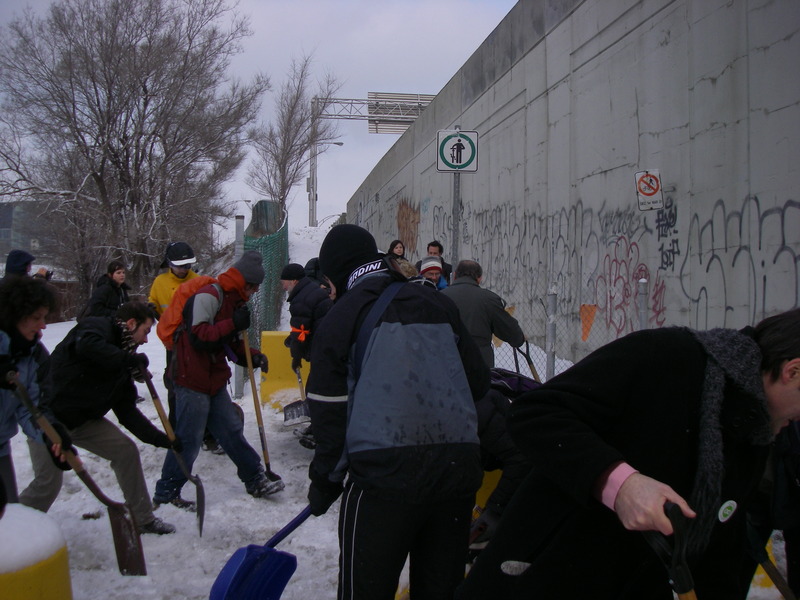BikeWriting: Please Plow the Jacques Cartier Bridge

Every winter, the Jacques Cartier bridge's five lanes choke with traffic while metal barriers block access to the separated bike-pedestrian lane that connects Montreal to Ile-Saint-Hélène and the South Shore.
Instead of waiting for the crown corporation that runs the bridge to recognize that active transport is a year-round endeavour, Colléctif vélo 365 will do it themselves: at 10 a.m. tomorrow morning, they will be hosting their second annual Shovel-In at the base of the bridge in Longueil.
It's as simple as it sounds: bring a shovel, a smile, maybe a bike, and help clear the path alongside the bridge. C'est tout.
A spokesperson for the coalition—which counts Équiterre, various student associations, and your friendly neighbourhood moving-by-bike company among its members—explained that the Jacques Cartier and Champlain Bridges Inc.'s increasingly repetitive reasons for keeping the bridge inaccessible to foot and bike traffic simply don't hold water.
For example, in a letter sent to the coalition, the federal body dismissed the idea that there might be a lot of people who commute from Longueil to Montreal by bike in the winter months, since, hey, they rarely ever see any cyclists on the bridge. That's right: the bridge that they block to cyclists.
"Even a child can see through their arguments," Francis Casaubon says while we chat in French, adding that many cyclists and pedestrians do in fact express a desire to cross the bridge, one that has so far been ignored at the federal level.
As quoted in a recent Gazette article, those in charge of the bridge essentially cite safety concerns and not wanting to get sued.
Casaubon's take is that the onus should be on the cyclist to adapt to the weather conditions. And he estimates that the width and height of the covered path is sufficiently large such that a standard sidewalk plow could easily take care of the job—though it would only be necessary only four or five times every winter, after the truly heavy snowfalls.
The fact that we couldn't fathom closing the bridge to cars to prevent accidents during or after a storm, while employing this same rhetoric to prevent cyclists from choosing their preferred mode of transport—"for ecological, economic and health reasons," as Causabon has said—speaks to the paternalistic attitude often used to dismiss bikes as a viable means of getting around.
"Why open the bridge for cars but not for bikes or pedestrians?" Causabon asks, not expecting an answer.
Yet even if the feds made an about-face and decided to keep the path open, the chances of it being sufficiently cleared aren't too hot.
Take Montreal's Réseau Slush, for example. I had thought about doing an on-the-ground reportage of the state of what is supposed be a cleared network of winter bikeways, but then I found that our distant-cousin-bike-blog already did it a couple years ago. And I would bet a nice old touring frame that the results haven't changed much.
The city may promise to keep this network cleared, but the fiscal responsibility falls on the boroughs. Some, like Rosemont and Ville-Marie, make an effort to keep them cleared, while others, like the Plateau, don't even bother.
Still, the message form Collectif vélo 365 and others is clear: Montreal-and-environners want to bike year round. They just need space to do it.
Related on maisonneuve.org:
—BikeWriting: Why Can't Drivers and Cyclists Just Get Along?
—Everybody's Talking About the Weather
—When the Streets Were Swept by Hand
Subscribe — Follow Maisy on Twitter — Like Maisy on Facebook





